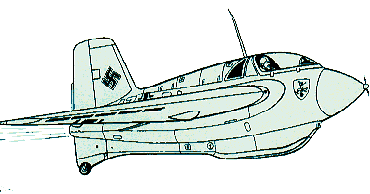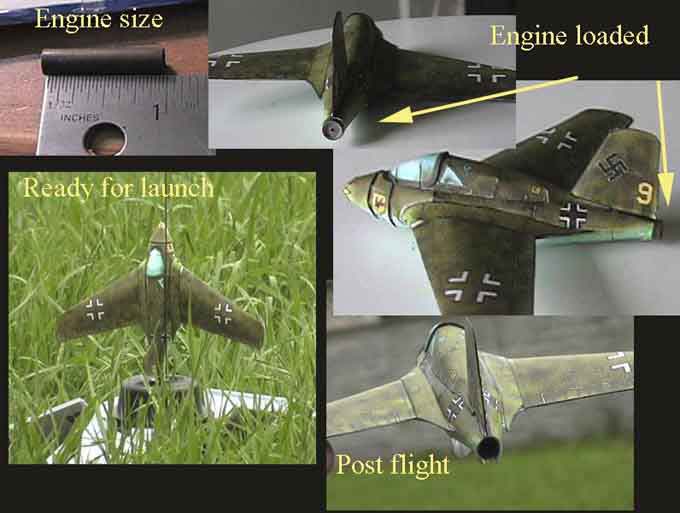THANKS FOR THE CLICK !!
You're welcome to download this free model and 2 other FREE museum class models of your choice (look for the red link at the top of your account page)
Sign up with (at least :) your email address so we can get them to you.
No obligation !! No surveys !! or data mining !! and most importantly, nobody else will ever get your email addy !!!
What we're doing is simply looking for more Modeln' Pals to enjoy this great hobby and possibly spend a few bucks on a few inexpensive and really great cardmodels
Click here to get started. If you're a teacher, click here.
airplane / building / misc
++++++++++++++
FYI
If you'd like to buy a few models, you might consider the DVD of the entire collection..
There's a point where you will really save money that way.
On your MyModels page, you'll see you'll see, in red, a 'hard times' offer for a bunch of free Magic Key models
(again.. of your choice) if you go for the $19.95 subscription for a year of all our new designs. Check it out
+++++++++++++++++
Messerschmitt ME-163 Komet Rocket
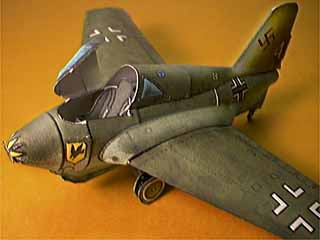 The top secret ME-163 was built as a last chance defense mechanism
for Germany's failing war effort beginning service in late 1943
as the only production rocket interceptor ever made.
The top secret ME-163 was built as a last chance defense mechanism
for Germany's failing war effort beginning service in late 1943
as the only production rocket interceptor ever made.
This little wonder was capable of climbing to 40,000 feet in just three minutes but with the high probability of the damn thing exploding upon landing, the risk made the strategic advantage to the Germans somewhat doubtful.
We've designed THREE different models so, if you'd like, you can
set up a little bevy of 'em. They're numbered differently and
the coloring is slightly different as well. This is the first
design of our up-and-coming 'Flying Wings' series.
Thank you for your great response to our call for ideas of what to include in the series.
THE world's first operational rocket-propelled fighter began life before the war when Dr Alexander Lippisch was asked to design a tailless aircraft to be powered by a Walter R 1-203 400-kg (882-lb) thrust rocket. A wooden test aircraft was begun under the designation DFS 194, but construction of the metal fuselage, considered necessary for the highly reactive rocket fuel, proved beyond the institute's resources, so in January 1939 Lippisch's team joined Messerschmitt and the design became the Me 163.
Delays to the program resulted in the wooden DFS 194 being fitted with the rocket, and when flight trials produced speeds of up to 550 km/h (342 mph) Messerschmitt was instructed to produce six Me 163A prototypes as a prelude to production Me l63Bs with much more powerful motors.
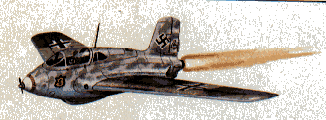 When fitted with a 750-kg
(1653-Ib) thrust R II-203b it was found that the maximum speed
of the Me 163A, at over 850km/h (528mph), was still restricted
by the limited amount of fuel that could be carried in the diminutive
airframe. Construction of the prototype and production
Me 163B airframes proceeded, but the new engines were late.
When fitted with a 750-kg
(1653-Ib) thrust R II-203b it was found that the maximum speed
of the Me 163A, at over 850km/h (528mph), was still restricted
by the limited amount of fuel that could be carried in the diminutive
airframe. Construction of the prototype and production
Me 163B airframes proceeded, but the new engines were late.
It was July 1943 before the intended engine was installed in one of the prototypes, and May 1944 before the first production B-la Komet entered Luftwaffe service: by July 1944 only 16 were operational.
In any case, although escorting fighters had little chance of intercepting the rockets, except on their un powered return flight, the latter, attacking at over 900 km/h (559 mph), had hardly any more chance of getting in an effective burst from their slow-firing MK 108s.
Some promise of success was offered by the Jagdfaust, a battery of 50-mm (1.97-in) shells fired automatically by an optical sensor reacting to a bomber's shadow, hut the war was over before it could be installed on a large scale. The introduction of an auxiliary combustion chamber for cruising flight on the prototype C-I was another promising line of development, but production was never begun.
The two-seat, un powered Me 163S trainer might also have reduced the number of accidents resulting from the heavy demands made on pilot skill by taking off from a jettisonable dolly and landing on a retractable skid, but the whole program had suffered too many delays for the Me 163 to become an effective weapon in the time available.
Me 163B-la
Type: single-seat rocket- powered interceptor Maker: Messerschmitt AG Span: 9.32m (3Oft 7in) Length: 5.69m (l8ft 8in) Height: 2.74m (8ft 113/4in) Wing area: 18.5m2 (l99.l4sq ft) Weight: normal 4310 kg (9502lb); empty 1905kg (4200 lb) Powerplant: one 1700-kg (3748-Ib) thrust Walter HWK 109-509A-l liquid- fueled rocket Performance: maximum speed 960 km/h (597 mph) at 9000 m (29 528 ft); range 80km (50 miles); operational ceiling 12000m (39370ft) Armament: two 30-mm (1.18-in) MK 108or20-mm (0.79-in) MG 151 cannon Crew: 1 Production: 279 |
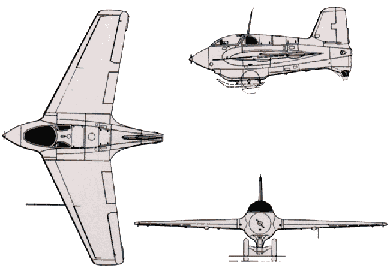 The Allies were astonished when they found out about the plans
and new designs for rocket weaponry in an advanced stage of manufacture
by the German technicians. A few of these weapons were actually
used during the war, but most of them never got past the experimental
stage. Nevertheless, they became useful prototypes for a good
many of today's modem weapons.
The Allies were astonished when they found out about the plans
and new designs for rocket weaponry in an advanced stage of manufacture
by the German technicians. A few of these weapons were actually
used during the war, but most of them never got past the experimental
stage. Nevertheless, they became useful prototypes for a good
many of today's modem weapons.
The Komet, for example, shown above, was a revolutionary fighter that could fly at almost 1,000km/h. It carried two 30mm cannon and eight 5cm rocket-launchers above the wings or 24 below the wings. Fritz X, shown below, was a 1,500kg bomb. It was released by a bomber and was guided by radio to its target. One of these bombs sank the battleship Roma.
On the right is a picture of the Rheintochter ground-to-air missile. It was a two-stage rocket with a proximity fuse, and it never passed the experimental stage. The Germans were also at work on a gigantic missile to launch against the United States from Europe.
Probably the most ingenious and radical German combat aeroplane to serve during World War 2, the Me 163 achieved no small degree of success during the nine months or so that it was in active service, although it reached operational units too late and in numbers too small to affect the ultimate outcome. It was based on the experimental DFS 194, designed in 1938 by Prof Alexander Lippisch and transferred, together with its staff, to the Messerschmitt AG for further development. But for the subsequent clash of personalities between Lippisch and Prof Willy Messerschmitt, and the delay in delivery of its rocket engines in later years, it would almost certainly have been in service much earlier.
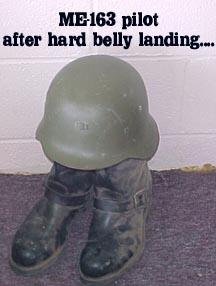
The first two Me 163 prototypes were flown in the spring of 1941 as un powered gliders, the Me 163V1 being transferred to Pee nem(indeed later that year to receive its 1,6531b (750kg) St HWK IL!! rocket motor. The first rocket-powered flight was made in August 1941, and in trials the fighter soon exhibited speeds of more than 620mph (1.000km/hr). Ten un powered Me 163As were completed late in 1941 as conversion trainers, and development of the fighter was accelerated.
The airframe of the third prototype (for the seventy Me 163E-0 and B-I production machines ordered) was completed in May 1942, but over a year elapsed before its new engine, the HWK 509A, became available. By then more than half of the original production batch were also complete except for their powerplant's. Additional Me 163 production was undertaken by Hans Klemm Flugzeugbau, the overall total being slightly more than three hundred and fifty.
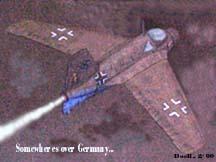 The first Luftwaffe unit to receive the Me 163B acquired its fighters
in June/July 1944, making its operational debut in mid-August
against US Eighth Air Force B-17s over Germany. The Komet's spectacular
speed, and the element of surprise, resulted in many early successes
against Allied bomber formations. However, the definitive version
was nearly a ton heavier than its original design weight, necessitating
the use of auxiliary booster rockets for take-off, while landings
were hazardous in the extreme.
The first Luftwaffe unit to receive the Me 163B acquired its fighters
in June/July 1944, making its operational debut in mid-August
against US Eighth Air Force B-17s over Germany. The Komet's spectacular
speed, and the element of surprise, resulted in many early successes
against Allied bomber formations. However, the definitive version
was nearly a ton heavier than its original design weight, necessitating
the use of auxiliary booster rockets for take-off, while landings
were hazardous in the extreme.
All too often the Me 163, landing directly on its fuselage keel-skid and with some of the highly inflammable fuel still left in the tank, would come to a literally comet-like end, with fatal results for its pilot. When the war ended the pressurized and improved Me 163C (HWK 5090 motor) had reached the pre-production stage, arid a prototype had also been flown of a derivative known first as the Me 163D and later as the Me 263, but this too was too late to go into production.


